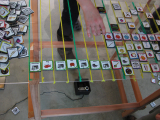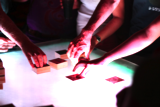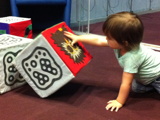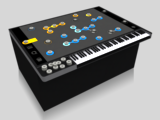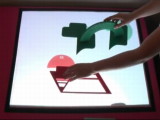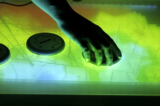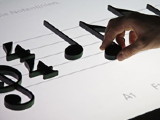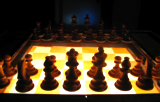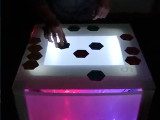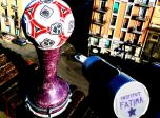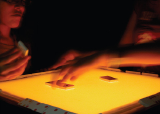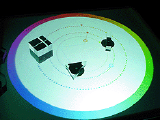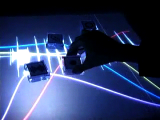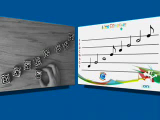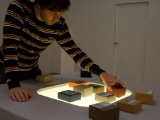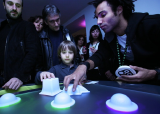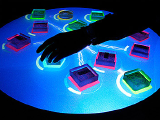Made with reacTIVision
-
dubtable
year: 2009
author(s): James Ashton Nichols
website: http://www.dubtable.net/
The Dubtable is an interactive tactile mixing table. It's an intuitive interface that invites the user to twist, crush and mash sounds together to make all new music. Anyone can participate and mix a track, dub out with delays and make a toon! Influenced by the simple but strange mixing techniques of early dub pioneers such as Lee Scratch and King Tubby, The Dubtable is based on reggae sounds, and provides a raw interface to explore and develop the making of song through mixes.
-
mixitui
year: 2008
author(s): Esben Pedersen,
Kasper Hornbæk
affiliation: Department of Computer Science, University of Copenhagen
publication: mixiTUI: A Tangible Sequencer for Electronic Live Performances [PDF]
website: http://www.mixitui.com/
mixiTUI is a tangible sequencer that allows electronic musicians to import and perform electronic music. mixiTUI is developed in collaboration with electronic musicians, with a focus on live arranging, on visualizations of music, on tokens that represent key elements in live performances, and on how the audience experiences the tangible interface.
-
Buildasound
year: 2010
author(s): Mónica Rikić
affiliation: Universitat Pompeu Fabra
publication: Buildasound Installation at TEI2013 [PDF]
website: http://monicarikic.com/portfolio/buildasound/
Buildasound is a sound building blocks game. It consists in creating shapes at the same time that you generate new sounds: there is no single objective (winning or losing), but instead the entertainment involved in playing for playing’s sake, and the opportunity to discover new melodies and constructions and constant creation based on the different positions of the cubes. The project was exhibited as part of the Ars Electronica Center collection in 2014/15 and has participated in several festivals such as SónarKids, FILE Festival Sao Paulo, FILE Games Rio, among others.
-
molekül 3000
year: 2008
author(s): Andreas Illiger
affiliation: Muthesius School of Art
website: http://www.incom.org/mkh/code/projekte/projekt_anzeigen.php?4,890,17,0,0,911
Molekül3000 is a tangible live-midi-sequenzer in the shape of an interactive table. It is possible to connect up to 16 sound generators to the table, which then can be controlled using clip and controller objects, which are placed, turned or moven on the table surface. Clip objects, which are placed on the table, can be programmed with melodies using the built in keyboard. Programmed clip objects can be triggered using a push-button and then send their note sequence to the sound generator. The controller objects allow to change parameters such as loudness, filter cutoff or pitch of each clip. molekül3000 allows the musician a new way to interact with loop-based live music and should invite to experimentation.
-
blues machine
year: 2009
author(s): Marcelo Cicconet,
Ilana Paterman,
Luiz Velho,
Paulo Cezar Carvalho
affiliation: VISGRAF Laboratory,
Rio de Janeiro
website: http://www.visgraf.impa.br/bm/
The blues machine is a multitouch, tangible interface for blues lovers. The interface features a multitouch surface with an attached string controller, which allows the simplified performance of music within the blues scale. The redundant string interface provides useful additional haptic feedback to the player.
-
Soundstrukt
year: 2009
author(s): Kamila Mikos, Simon Doury
website: http://www.sonorama.org
The Soundstrukt project evolved around the concept of sound motifs, each form corresponds to a sound with a sonic and graphical identity. Through the tangible media the user is thus led to create extensible sound patterns, by using the "loop" object these sound patterns may overlap. This set of sonic layers makes it possible to construct complex music from simple sound structures. The control surface becomes both a visual and audible moving picture.
-
Bricktable
year: 2008
author(s): Jordan Hochenbaum,
Owen Vallis
affiliation: California Institute of the Arts
website: http://bricktable.wordpress.com/
"Weather Report" is the first piece of custom software to explore the uses of the Brick Table. It is a sonification piece intended to take some sort of data, and use it in a meaningful and musical way. When you look at Brick Tables screen, you will see a colorful map of the U.S., which is showing the current surface temperature of the United States. Split sectionally/regionally across the screen are 9 different audio loops. The user has three puck-like objects that can be used in different ways to create music.
-
noteput
year: 2009
author(s): Jonas Friedemann Heuer
affiliation: HfG Schwäbisch Gmünd
website: http://www.jonasheuer.de/index.php/noteput/
Noteput is an interactive music table with tangible notes, that combines all three senses of hearing, sight and touch to make learning the classical notation of music for children and pupils more easy and interesting. All basic clefs, note values and accidentals exist as single wood elements. Whole, half, quarter and eighth notes differ not only in their form, but also in their weight: Long note values are heavier than short ones. The table has two modes: A standard mode, where you can place notes on the table in a playful and experimental way and explore the related music outcome. And an exercise mode, where exercises and tutorials sort by topic and difficulty have to be mastered.
-
chessynthesis
year: 2007
author(s): Marion Maxime
website: http://maniaxmemori.net/chessynthesis.html
Chessynthesis is a performance project. It consists in a classical chess game, with a chessboard and 32 pieces, but a captation system analyzes the position and the evolution of the gameplay, and transcode it to sound. At the start of the game, you can see two players in the front of a chessboard, and you hear a little and soft sound. When the first player starts to move a piece, you can hear the dynamic variation of his movings. The goal is to reinterpret each tactical and strategical position in an sonic and harmonic way.
-
looplex
year: 2009
author(s): Marcus Holzmayr, Cornelius Pöpel
affiliation: Hochschule Ansbach
publication: LOOPLEX - Interaktives Sound Interface [PDF]
LOOPLEX is a tangible user interface prototype for live sound interaction based on reacTIVision, MaxMSP, Ableton Live and Arduino. The generated tracking data is received by the MaxMSP TUIO-Client and converted into Midi NoteOn/Off and Midi CC-Data depending on the object angle. This Midi-Data is mapped within Ableton Live for triggering Audio-Loops or Effects. While triggering an Audio-Clip in Ableton Live a Midi-Clip containing Note-On/Off and Pitchbends is triggered simultaneously and routed to MaxMSP. This information controls 6 coloured LEDs (2xRGB) connected to the 6 digital PWM-Ports on the Arduino board, allowing simple on/off states, smooth colour changes and additive colour processing.
-
Das reacBall
year: 2009
author(s): Paul Rose, Carsten Galle
affiliation: Institut Fatima
website: http://www.institutfatima.org/
"There is no absolute control, but rather a small dose of chaos which stimulates creativity". Institut FATIMA apply this idea to "The Reacball System," in which a football, a camera, a computer and a MIDI controller generate a remix of sounds, samples and slips. The ball generates random sequences of MIDI notes which de-control a musical arrangement. The MIDI controller rearranges the chaos dialectically.
-
Dominotes
year: 2007
author(s): Charbel Akhras, Peter van Lanschot, Zoomy Zhang, John Basklavanis
affiliation: Interactive Media, University of the Arts London
website: http://www.dominotes.org.uk/
Dominotes is an interactive multi-user installation that adds a musical dimension to a traditional game transporting it to a new level. The game of dominoes is a classic that instils a sense of nostalgia in people. Although it may be a new game for some, it is its simplicity and familiarity that appeals to us. Everyone plays it in their own way.
-
Harmonia
year: 2008
author(s): Yoon Chung Han
affiliation: College of Fine arts, Seoul National University
website: http://www.mohoya.com/Portal/harmonia.html
Harmonia came from Pythagorean principle of Harmonia believed that each element was structured by a different harmony: earth is a cube, fire a pyramid, water an icosahedron, air a triangle. The world was not dominated by forces, but rather arranged in an orderly and structured (mathematical) way. Basically everything has a mathematical form. That principle can certainly be applied to my sound visualization's fundamental concept. There are two versions of Harmonia: Each object in version one has its own center in circle and this means it does not produce any change of speed. However, every objects in version two have one unchangeable center in one big circle and velocity can be changed depending on their objects' existences on x, y axis.
-
waveTable
year: 2008
author(s): Gerard Roma,
Anna Xambo
affiliation: Music Technology Group,
Universitat Pompeu Fabra, Barcelona
publication: A tabletop waveform editor for live performance [PDF]
An audio waveform editor that can be operated in real time through a tabletop interface. The system combines multi-touch and tangible interaction techniques in order to implement the metaphor of a toolkit that allows direct manipulation of a sound sample. The resulting instrument is well suited for live performance based on evolving loops.
-
Live Composer
year: 2007
author(s): Seth Sandler
affiliation: ICAM, University of California, San Diego
website: http://ssandler.wordpress.com/
Physical blocks (with Fiducial Symbols) are moved around on a table and they correlate to time and pitch. Moving the blocks creates a visual in flash which notates and plays back the composition in real-time. Moving vertically changes the pitch, while moving horizontally changes the order of these notes over time
-
Etiquette
year: 2007
author(s): Tommy Perman, Simon Kirby
website: http://etiquette.surfacepressure.net/
Etiquette is an ambitious interactive audio installation commissioned by the Edinburgh Sculpture Workshop (ESW)
-
ExploraTune
year: 2009
author(s): Alexandar Chee, Bowen Li, Mike Lindquist, Seng Keat Teh
affiliation: HCI Group, Stanford University
website: http://hci.stanford.edu/cs247/2009/websites/ExploraTunes/home.html
ExploraTune is a musical toy that allows you to create fun and meaningful compositions. It helps you to recognize new musical instruments and to learn how they interact with one another. ExploraTune can be played alone or with friends. ExploraTune is easy to use! You simply pick an instrument tile and place it on the table. When the music reaches your column it will play the tile you placed. The light indicates which column the table is currently playing. The table plays all tiles in the same column. Each column represents 1 beat in a 4 beat measure. There are 16 columns on the table. The table plays 1 column at a time, from left to right, and repeats when it reaches the end.
-
Social Soundmachine
year: 2007
author(s): Ramon Schreuder
website: http://www.feelingthemusic.com/
reactable clone: The Social Soundmachine is an interactive multi-touch installation, which connects people by enabling them to collaborate on music. Using a clear user interface with tangible objects, they create a unique musical track from a variety of samples and sound effects.
-
I.M.Table
year: 2009
author(s): Front Pictures
website: http://frontpictures.com/index.php/en/imtable
reactable clone: Interactive media table is a multiuser musical instrument that helps multiple artists to create music by moving special markers on the table's surface.
